Ecommerce has exploded in recent years, but 2025 is shaping up to be a pivotal year. Why? Because competition is fiercer, customer expectations are higher, and technology is evolving faster than ever. If you’re running an online store, you need more than just a great product—you need a smart, data-driven ecommerce marketing strategy to stand out and convert browsers into buyers.
This guide is your one-stop resource to mastering ecommerce marketing in 2025. We’ll walk you through proven strategies, introduce you to game-changing tools like Crest Fly for lead generation, and break down exactly what you need to do to drive traffic, improve conversions, and grow sustainably.
Let’s dive in, step-by-step.
Understanding Ecommerce Marketing
What is Ecommerce Marketing?
Ecommerce marketing is the practice of driving awareness and action toward a business that sells products or services online. It involves a wide range of strategies and channels including content marketing, social media, email campaigns, SEO, PPC, and more.
The goal? To bring potential customers to your website and guide them through the sales funnel until they make a purchase—and hopefully, keep coming back for more. But it doesn’t stop there. Retention, loyalty, upselling, and customer lifetime value are all important pieces of the ecommerce marketing puzzle.
In 2025, the line between marketing and customer experience is blurrier than ever. Consumers expect personalized interactions, lightning-fast service, and value at every touchpoint. Ecommerce marketing isn’t just about shouting louder—it’s about building smarter, more meaningful connections.
Why Ecommerce Marketing Matters in 2025
Still wondering why ecommerce marketing is such a big deal? Here’s the reality: over 2.77 billion people are expected to shop online in 2025. That’s a mind-blowing audience you can’t afford to ignore. But reaching them isn’t as simple as putting up a website and waiting for the sales to roll in.
You need a strategy that’s built on:
- Trust and credibility
- High-quality traffic
- Relevant messaging
- Seamless UX/UI
- Smart retargeting
- Proven conversion tactics
With changes to third-party cookies, AI-driven search, and rising ad costs, the way we market online is shifting. If you’re not staying ahead, you’re falling behind. Ecommerce marketing in 2025 demands agility, insight, and tools like Crest Fly that supercharge your lead generation and conversion efforts.
Types of Ecommerce Marketing Strategies
You can’t rely on just one marketing method and expect results. A successful ecommerce marketing strategy uses a blend of techniques that work together to attract, nurture, and convert your audience. Let’s break them down.
Content Marketing
Content is still king—especially in ecommerce. But it’s not just about blog posts anymore. In 2025, effective content marketing includes:
- Product guides
- Comparison articles
- Customer stories
- Videos and reels
- FAQs and tutorials
Well-optimized content drives SEO rankings, builds trust, and educates your audience. Plus, Google loves content that answers real questions. Want an example? This very article you’re reading is content marketing in action.
Here’s how to succeed:
- Focus on search intent—what is the customer actually trying to find?
- Use long-tail keywords to target niche buyers.
- Repurpose content across platforms (e.g., turn blog posts into Instagram carousels).
- Keep your content fresh, relevant, and user-focused.
Remember: Your content should always aim to help, not just sell.
Email Marketing
Email isn’t dead. In fact, it’s thriving—especially in ecommerce. Why? Because it allows for personalized, direct communication with people who’ve already shown interest in your brand.
Smart email marketing drives retention, loyalty, and repeat purchases. Use it to:
- Welcome new subscribers
- Remind customers of abandoned carts
- Send personalized product recommendations
- Share exclusive deals and updates
- Request reviews or referrals
Segment your list by behavior, purchase history, or location. A one-size-fits-all email won’t cut it in 2025.
Tools like Crest Fly can help you capture emails with popups, quizzes, and landing pages—so you’re not just driving traffic, you’re building a community.
Social Media Marketing
Love it or hate it, social media is a powerhouse in ecommerce marketing. Instagram, TikTok, Facebook, and even Pinterest are where your customers are hanging out, discovering products, and making buying decisions.
Effective social media marketing in 2025 is:
- Authentic: People crave transparency and human interaction.
- Visual-first: Short-form videos and bold imagery win attention.
- Community-driven: Focus on engagement, not just promotion.
Use social proof (like UGC and reviews), host giveaways, and collaborate with micro-influencers to build buzz. And always have a clear CTA driving users to your site.
Need help turning followers into customers? That’s where Crest Fly’s lead generation tools come into play, helping you convert social traffic into real revenue.
SEO for Ecommerce Websites
On-Page SEO Tactics
If you want your ecommerce site to show up in search results, you’ve got to master on-page SEO. It’s one of the most important (and controllable) elements of your digital marketing strategy.
On-page SEO is all about optimizing the individual pages of your website so that they rank higher and attract more relevant traffic. Here’s how to get it right in 2025:
- Keyword-Rich Titles and Meta Descriptions: Make sure your product titles, page titles, and meta descriptions include high-intent keywords that match what your target customers are actually searching.
- Descriptive Product Pages: Use unique, detailed product descriptions with semantically relevant terms. Avoid copying manufacturer descriptions—it won’t help with SEO.
- Image Optimization: Compress images for faster load time and use descriptive alt text to help with search visibility (and accessibility).
- Internal Linking: Guide visitors to related products, categories, and blog content. This keeps users on-site longer and helps search engines crawl your site better.
- Mobile Responsiveness: With mobile-first indexing, Google prioritizes how your site performs on phones and tablets.
Don’t forget to implement schema markup for products, reviews, FAQs, and breadcrumbs. It enhances your appearance in SERPs with rich results and boosts your click-through rates.
Technical SEO Essentials
Even if your content is great, poor technical SEO can tank your rankings. Search engines need to crawl and index your site efficiently, and users expect lightning-fast performance.
Here’s what you need to pay attention to:
- Site Speed: Every second counts. Use tools like Google PageSpeed Insights to check performance and reduce load times by optimizing images, using lazy loading, and enabling browser caching.
- Secure Website (HTTPS): Security is non-negotiable. Google favors secure sites, and users trust them more.
- Clean URL Structure: Use simple, readable URLs that include keywords. For example:
/mens-running-shoesis better than/product123?id=55. - Fix Broken Links and 404 Errors: These hurt user experience and SEO. Monitor your site regularly using tools like Screaming Frog or Ahrefs.
- Sitemap and Robots.txt: Ensure your sitemap is updated and submitted to Google Search Console. Your robots.txt file should guide bots properly—not block essential pages.
Technical SEO isn’t glamorous, but it’s foundational. Without it, all your content and marketing efforts won’t reach their full potential.
Off-Page SEO Strategies
Off-page SEO refers to everything that happens outside your website that helps improve your search engine rankings. In 2025, link building is still the king of off-page SEO, but it’s about quality over quantity.
Here’s how to build a strong off-page SEO game:
- Backlinks from Authority Sites: Reach out to reputable blogs, ecommerce publications, or industry news sites for guest posts or product mentions.
- Influencer Collaborations: Get your products reviewed or recommended by influencers with engaged followings. Their content can drive both traffic and quality backlinks.
- Social Signals: While not a direct ranking factor, social shares and engagement can help your content get discovered and linked to naturally.
- Directory Listings and Citations: Make sure your business is listed consistently across relevant directories with accurate name, address, and phone number (NAP).
- Customer Reviews: Google trusts user-generated content. Encourage customers to leave reviews on Google, Trustpilot, and niche platforms.
Pro tip: Use digital PR strategies to get your brand featured in news stories, listicles, and expert roundups. It’s a great way to build both authority and visibility.
The Role of CRO (Conversion Rate Optimization) in Ecommerce
Getting traffic to your ecommerce site is just one part of the equation. The other, arguably more important part, is converting that traffic into paying customers. That’s where CRO—conversion rate optimization—comes in.
Improving Site Speed and User Experience
A slow, clunky website is a conversion killer. Visitors expect instant gratification, and even a 1-second delay in page load time can cause a major drop in conversions.
Here’s how to optimize the user experience for higher conversion rates:
- Clean, Minimal Design: Don’t overcrowd your site. A simple, focused layout with clear CTAs works best.
- Fast Load Times: As mentioned earlier, site speed is crucial. Compress assets and eliminate unnecessary scripts.
- Mobile Optimization: Mobile traffic dominates ecommerce. Ensure your site is fully responsive and touch-friendly.
- Easy Navigation: Organize your menu logically and include a powerful on-site search function. Customers should be able to find what they’re looking for in seconds.
- Trust Signals: Display badges for secure payments, customer reviews, and money-back guarantees.
Every tweak you make should be geared toward removing friction and making the path to purchase smoother.
A/B Testing and Landing Page Optimization
You can’t improve what you don’t measure. A/B testing lets you test different elements of your site to see what performs better. It’s essential for fine-tuning your ecommerce strategy.
What should you A/B test?
- CTA buttons (color, text, placement)
- Product descriptions
- Images and videos
- Headline text
- Layout and navigation
Tools like Google Optimize, VWO, or Optimizely make it easy to set up split tests. Just remember to test one element at a time for clear results.
Landing pages also deserve special attention. For promotions, seasonal campaigns, or lead magnets, create dedicated landing pages with a singular focus. Use strong headlines, minimal distractions, and a clear value proposition.
Bonus tip: Integrate Crest Fly’s lead capture features into your landing pages to increase form submissions and boost your email list.
Lead Generation in Ecommerce with Crest Fly
Introduction to Crest Fly
Now let’s talk about one of the most powerful tools in your ecommerce marketing toolbox: Crest Fly. If lead generation has ever felt like a black hole where good traffic goes to die, Crest Fly is your solution.
Crest Fly is a dynamic, user-friendly lead generation platform designed to help ecommerce businesses collect more leads, engage them meaningfully, and turn them into loyal customers.
It specializes in:
- Popups and slide-ins
- Exit-intent forms
- Quizzes and surveys
- Landing page builders
- Behavior-triggered automation
Unlike generic popup tools, Crest Fly is built with ecommerce in mind, meaning everything is optimized for conversions, user experience, and sales growth.
How Crest Fly Helps Capture and Convert Leads
Crest Fly doesn’t just collect emails—it helps qualify and nurture those leads into sales-ready customers. Here’s how:
- Intelligent Targeting: Show different messages based on visitor behavior, location, or device.
- Gamified Popups: Use spin-to-win wheels, quizzes, or interactive forms to boost opt-in rates.
- A/B Testing Built-In: Optimize your lead capture forms without needing external tools.
- CRM and Email Integration: Easily sync with email platforms like Mailchimp, Klaviyo, and more.
- Custom Landing Pages: Build fast-loading, conversion-focused landing pages with zero coding.
Think about it: you spend money driving traffic to your site through ads, SEO, and social. But if you’re not capturing leads, you’re letting that investment go to waste. Crest Fly ensures every visitor has the potential to become a customer.
Real Case Studies Using Crest Fly for Ecommerce
Let’s bring it home with some real-world examples. Ecommerce stores that implemented Crest Fly saw dramatic improvements in their lead generation efforts:
- Fashion Brand A: Increased email subscribers by 45% in 30 days using timed popups and product-based triggers.
- Gadget Store B: Recovered 20% of abandoned carts using Crest Fly’s exit-intent strategy.
- Supplement Company C: Grew its SMS list by 60% through gamified opt-ins and mobile-specific targeting.
These results are not rare—they’re repeatable. The key is using the platform strategically and continuously optimizing based on user behavior.
Personalization and Customer Experience
AI and Machine Learning in Ecommerce
In 2025, ecommerce personalization is no longer a “nice-to-have”—it’s the standard. If you’re not using AI to personalize experiences, you’re missing out on both sales and customer satisfaction.
Artificial intelligence allows ecommerce businesses to analyze mountains of customer data and then use it to deliver tailored experiences. Here’s how:
- Dynamic Pricing: AI can adjust pricing based on demand, user behavior, and inventory levels.
- Behavioral Predictions: It predicts what customers might like or need next, making upselling and cross-selling way more effective.
- Chatbots and Virtual Assistants: AI-powered bots can handle FAQs, suggest products, and even guide customers through the buying process.
Machine learning improves over time, meaning the more you use it, the smarter it gets. Imagine being able to recommend products before your customers even realize they want them—that’s the power of AI in ecommerce.
Implementing AI might sound complex, but many platforms now offer plug-and-play AI tools that integrate directly into your store. The results? Better engagement, higher conversion rates, and a stronger customer relationship.
Product Recommendations and Personal Touchpoints
Want to delight your customers and boost your average order value at the same time? Personalized product recommendations are the way to go.
Smart ecommerce stores use a customer’s browsing and purchase history to suggest:
- Related products
- Frequently bought together items
- Refill or subscription options
- “You might also like” alternatives
These suggestions can be embedded on product pages, in the cart, post-checkout, or even in follow-up emails. It’s subtle, but powerful—like having a personal shopper built into your store.
Additionally, don’t underestimate the impact of personal touchpoints:
- Birthday offers
- Thank-you emails
- Loyalty rewards
- Special VIP discounts
These gestures show customers they’re more than just a number. And that kind of connection builds long-term loyalty.
Mobile Marketing and Ecommerce
Importance of Mobile Optimization
Let’s be real: mobile is the backbone of ecommerce in 2025. Over 70% of ecommerce traffic comes from smartphones, and if your site isn’t optimized for mobile, you’re losing money—period.
Here’s what makes a mobile-optimized ecommerce experience:
- Responsive Design: Your site should adapt to any screen size flawlessly.
- Touch-Friendly UI: Buttons, filters, and forms need to be easy to use with thumbs.
- Fast Load Times: Mobile users are even less patient than desktop users. Speed is crucial.
- Simplified Checkout: Use autofill, mobile wallets like Apple Pay/Google Pay, and one-click checkouts.
Google also uses mobile-first indexing, meaning your mobile site is what they consider first for ranking. So if your mobile game is weak, your SEO will suffer too.
Not sure where to start? Use tools like Google’s Mobile-Friendly Test and PageSpeed Insights to identify areas for improvement.
Mobile App vs. Mobile Website
This is a common question: Should I build a mobile app for my ecommerce store?
Here’s the breakdown:
- Mobile Website:
- Easier and cheaper to build
- Accessible to anyone with a browser
- Great for discovery and first-time users
- Mobile App:
- Best for repeat customers and loyalty programs
- Enables push notifications
- Offers a smoother, faster experience
- Can increase AOV and retention
If you’re just starting out, a killer mobile website is a must. But if you have a loyal customer base and want to scale engagement, investing in an app could be a game-changer.
Pro Tip: Use Crest Fly to drive mobile app installs through personalized exit-intent popups and segmented email flows.
Using Data Analytics in Ecommerce
Tracking Customer Behavior
Data is your ecommerce business’s superpower—if you know how to use it.
Tracking customer behavior helps you understand:
- Where users are coming from
- What pages they visit
- Where they drop off
- What influences their buying decisions
Use tools like:
- Google Analytics 4 for in-depth traffic insights
- Hotjar or Crazy Egg for heatmaps and user recordings
- Klaviyo or HubSpot for customer lifecycle and email behavior tracking
With the right analytics setup, you can segment users by behavior and tailor your marketing efforts for each group. For example:
- New visitors get welcome offers
- Cart abandoners get follow-up emails
- Loyal customers get referral incentives
This kind of precision helps you spend less and convert more.
Optimizing Marketing Campaigns Based on Data
What’s working? What’s not? These are questions data can answer instantly—if you’re watching the right metrics.
Here are a few campaign metrics every ecommerce marketer should track:
- Customer Acquisition Cost (CAC)
- Customer Lifetime Value (CLV)
- Email Open and Click-Through Rates
- Return on Ad Spend (ROAS)
- Cart Abandonment Rate
- Bounce Rate
Regularly review these numbers and tweak your campaigns accordingly. Maybe your email subject lines need more punch. Maybe your ads are attracting the wrong audience. Data will show you where to pivot.
And don’t forget—tools like Crest Fly help you capture more leads upfront, so even if someone doesn’t buy right away, you’ve still got their info for retargeting.
Retargeting Strategies for Ecommerce
How Retargeting Works
You know that feeling when you browse a product, leave the site, and suddenly it follows you around the internet? That’s retargeting—and it’s one of the most effective ecommerce marketing tactics out there.
Retargeting works by placing a tracking pixel on your website that logs visitor behavior. Then, when that visitor goes to another website or platform (like Facebook or Google), they see ads for the product they viewed.
Why it works:
- It reminds users of what they were interested in
- It builds familiarity with your brand
- It reduces the time-to-purchase cycle
Retargeting campaigns often yield 2-3x higher conversion rates than standard ads.
Best Platforms for Ecommerce Retargeting
Here are the top platforms for launching your retargeting campaigns:
- Google Ads (Display + Search Retargeting)
- Facebook + Instagram (Meta Ads)
- TikTok (Video Retargeting)
- Pinterest (Product Pin Reminders)
- Email Retargeting via Abandoned Cart Flows
Pro Tip: Combine retargeting with Crest Fly’s popups and landing pages. Capture a lead before they leave your site, then nurture them with follow-ups until they convert.
You’re not just chasing lost traffic—you’re bringing it back smarter, stronger, and ready to buy.
Conclusion
Ecommerce marketing in 2025 isn’t about throwing spaghetti at the wall and hoping something sticks. It’s about precision, personalization, and persistence. The landscape has shifted—customers are savvier, competition is fiercer, and the tech is more powerful than ever.
To win in this evolving space, you need a smart, multi-channel strategy that blends SEO, CRO, content marketing, social proof, analytics, and mobile optimization. Each piece works like a cog in the larger machine—turning browsers into buyers and buyers into loyal fans.
And speaking of machines, Crest Fly is a lead generation powerhouse that you shouldn’t overlook. Its ecommerce-centric approach helps you not only capture leads but convert and nurture them efficiently. Whether you’re a startup or scaling enterprise, Crest Fly adds serious firepower to your marketing arsenal.
Success in ecommerce doesn’t just come from having the best product. It comes from reaching the right people, at the right time, with the right message—and giving them a smooth, enjoyable path to purchase. Nail that, and the rest will follow.
Let this be your roadmap. Now go take action and turn traffic into transactions.
FAQs
1. What is the best ecommerce marketing strategy in 2025?
The best ecommerce marketing strategy is a balanced mix of SEO, content marketing, social media, email automation, and conversion rate optimization. It’s also essential to use tools like Crest Fly for effective lead generation and personalization to maximize ROI across every stage of the customer journey.
2. How does Crest Fly help with ecommerce lead generation?
Crest Fly provides smart popups, gamified opt-ins, exit-intent forms, and behavior-based triggers that help ecommerce sites capture more leads. It integrates with major CRMs and email tools, making it easy to build targeted lists and convert visitors into paying customers—without annoying them.
3. How important is SEO for ecommerce websites?
SEO is absolutely critical. It drives organic traffic, builds trust, and reduces your reliance on paid ads. A strong SEO foundation—including keyword research, optimized product pages, technical performance, and backlinks—ensures your store ranks well and gets consistent traffic over time.
4. What are the most effective retargeting platforms for ecommerce?
Top retargeting platforms include Google Display Ads, Meta (Facebook/Instagram), TikTok, Pinterest, and email. Each platform allows you to reconnect with visitors who didn’t convert the first time and bring them back with tailored offers and reminders.
5. Do I need a mobile app for my ecommerce business?
Not necessarily. A well-optimized mobile website is essential and may be enough for smaller businesses. But if you have a growing, loyal customer base and want to increase retention and engagement, developing a mobile app can be a smart next step. Apps enable push notifications, faster browsing, and deeper customer loyalty.




